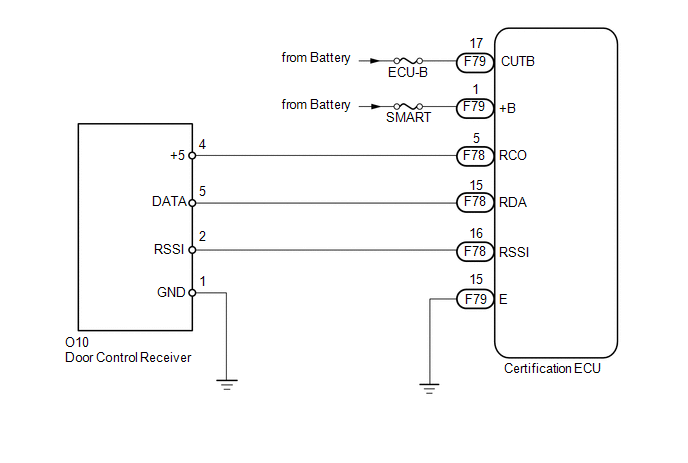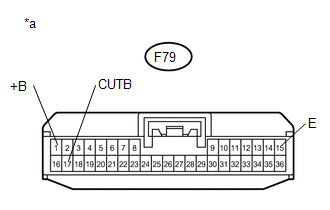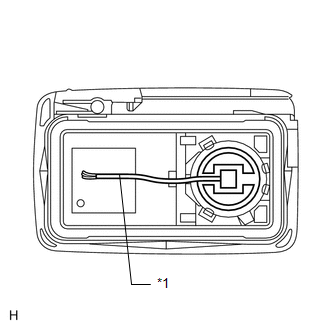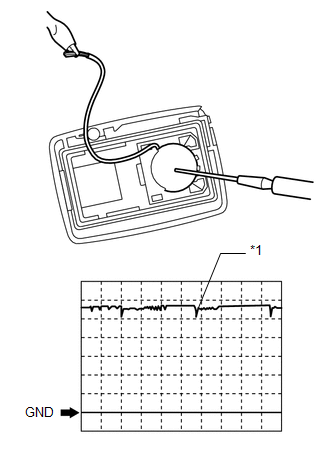Toyota 4Runner: All Door Entry Lock/Unlock Functions and Wireless Functions do not Operate
DESCRIPTION
When the entry operation and wireless operation of the door lock functions do not operate, a malfunction or wave interference may be occurring in either of the following: 1) the signal communication line between the door control receiver and certification ECU (the line is used by entry and wireless operations); or 2) the electrical key transmitter.
WIRING DIAGRAM

CAUTION / NOTICE / HINT
NOTICE:
- The smart key system (for Entry Function) uses a multiplex communication
system (LIN communication system) and the CAN communication system. Inspect
the communication function by following How to Proceed with Troubleshooting
(See page
.gif) ). Troubleshoot the smart key
). Troubleshoot the smart key
system (for Entry Function) after confirming that the communication systems are functioning properly. - When using the Techstream with the engine switch off to troubleshoot: Connect the Techstream to the DLC3 and turn a courtesy light switch on and off at 1.5-second intervals until communication between the Techstream and vehicle begins.
- Check that there are no electrical key transmitters in the vehicle.
- Before performing the inspection, check that DTC B1242 (wireless door
lock control) is not output (See page
.gif) ).
).
- Inspect the fuses for circuits related to this system before performing the following inspection procedure.
- When checking the entry lock operation multiple times, the lock operation may be limited to 2 consecutive operations depending on the settings. In order to perform the entry lock operation 3 or more times, an unlock operation must be performed once (any type of unlock operation is sufficient). However, only consecutive entry lock operations are limited. Using the wireless lock or other types of lock operations, it is possible to perform consecutive lock operations without this limitation.
- Before replacing the certification ECU, refer to the engine immobiliser
system (w/ Smart Key System) (See page
.gif)
).
PROCEDURE
|
1. |
CHECK POWER DOOR LOCK CONTROL SYSTEM |
(a) When the door control switch on the multiplex network master switch assembly
is operated, check that the doors unlock and lock according to the switch operation
(See page .gif) ).
).
OK:
Door locks operate normally.
| NG | .gif) |
GO TO POWER DOOR LOCK CONTROL SYSTEM |
|
|
2. |
CHECK ELECTRICAL KEY TRANSMITTER |
(a) When another registered electrical key transmitter is used, check that the
wireless and entry functions operate normally (See page
.gif) ).
).
Result
|
Result |
Proceed to |
|---|---|
|
Entry function operates |
A |
|
Entry function does not operate |
B |
| B | .gif) |
GO TO STEP 5 |
|
|
3. |
CHECK ELECTRICAL KEY TRANSMITTER (LED) |
(a) Check that the transmitter LED illuminates 3 times when a switch is pressed 3 times.
Result|
Result |
Proceed to |
|---|---|
|
Transmitter LED does not illuminate when switch is pressed 3 times |
A |
|
Transmitter LED illuminates 3 times when switch is pressed 3 times |
B |
|
Transmitter LED does not illuminate second or third time |
C |
HINT:
If the transmitter LED does not illuminate the second or third time, replace the transmitter battery as it is depleted.
| B | .gif) |
REPLACE ELECTRICAL KEY TRANSMITTER |
| C | .gif) |
REPLACE TRANSMITTER BATTERY |
|
|
4. |
INSPECT TRANSMITTER BATTERY (VOLTAGE) |
|
(a) Remove the battery from the electrical key transmitter that does
not operate (See page |
|
(b) Attach a lead wire (0.6 mm (0.0236 in.) in diameter or less including wire sheath) with tape or equivalent to the negative terminal.
Text in Illustration|
*1 |
Lead Wire |
NOTICE:
Do not wrap the lead wire around a terminal, wedge it between terminals, or solder it. The terminal may be deformed or damaged, and the battery will not be able to be installed correctly.
(c) Carefully pull the lead wire out from the position shown in the illustration and install the previously removed transmitter battery.
|
(d) Using an oscilloscope, check the transmitter battery voltage waveform. HINT: When measuring the battery voltage, bring the electrical key transmitter
within the entry operating range while operating the lock sensor of a door
handle to perform the measurement. For the entry operating range, refer
to System Description (See page Standard Voltage:
|
|
| OK | .gif) |
REPLACE ELECTRICAL KEY TRANSMITTER |
| NG | .gif) |
REPLACE TRANSMITTER BATTERY |
|
5. |
CHECK WAVE ENVIRONMENT |
(a) Bring the electrical key transmitter near the door control receiver and perform a wireless and entry function operation check.
HINT:
- When the electrical key transmitter is brought near the door control receiver, the possibility of wave interference decreases, and it can be determined if wave interference is causing the problem symptom.
- If the inspection result is that the problem only occurs in certain locations or at certain times of day, the possibility of wave interference is high. Also, added vehicle components may cause wave interference. If installed, remove them and perform the operation check.
OK:
Wireless and entry functions operate normally.
| OK | .gif) |
AFFECTED BY WAVE INTERFERENCE |
|
|
6. |
CHECK POWER SOURCE |
(a) Check that the combination meter display turns off when the engine switch is turned off.
OK:
Combination meter turns off.
HINT:
This confirms that systems other than the smart key system are correctly detecting the state of the power source.
| NG | .gif) |
GO TO SMART KEY SYSTEM (FOR START FUNCTION) |
|
|
7. |
CHECK HARNESS AND CONNECTOR (CERTIFICATION ECU - BATTERY AND BODY GROUND) |
(a) Disconnect the F79 ECU connector.

(b) Measure the voltage according to the value(s) in the table below.
Standard Voltage:
|
Tester Connection |
Condition |
Specified Condition |
|---|---|---|
|
F79-17 (CUTB) - Body ground |
Always |
11 to 14 V |
|
F79-1 (+B) - Body ground |
Always |
11 to 14 V |
(c) Measure the resistance according to the value(s) in the table below.
Standard Resistance:
|
Tester Connection |
Condition |
Specified Condition |
|---|---|---|
|
F79-15 (E) - Body ground |
Always |
Below 1 Ω |
|
*a |
Front view of wire harness connector (to Certification ECU) |
| NG | .gif) |
REPAIR OR REPLACE HARNESS OR CONNECTOR |
|
|
8. |
CHECK HARNESS AND CONNECTOR (DOOR CONTROL RECEIVER - CERTIFICATION ECU AND BODY GROUND) |
(a) Disconnect the O10 receiver connector.
(b) Disconnect the F78 ECU connector.
(c) Measure the resistance according to the value(s) in the table below.
Standard Resistance:
|
Tester Connection |
Condition |
Specified Condition |
|---|---|---|
|
O10-4 (+5) - F78-5 (RCO) |
Always |
Below 1 Ω |
|
O10-5 (DATA) - F78-15 (RDA) |
Always |
Below 1 Ω |
|
O10-2 (RSSI) - F78-16 (RSSI) |
Always |
Below 1 Ω |
|
F78-5 (RCO) - Body ground |
Always |
10 kΩ or higher |
|
F78-15 (RDA) - Body ground |
Always |
10 kΩ or higher |
|
F78-16 (RSSI) - Body ground |
Always |
10 kΩ or higher |
|
O10-1 (GND) - Body ground |
Always |
Below 1 Ω |
| NG | .gif) |
REPAIR OR REPLACE HARNESS OR CONNECTOR |
|
|
9. |
CHECK DOOR CONTROL RECEIVER (OPERATION) |
(a) Temporarily replace the door control receiver with a new or normally functioning
one (See page .gif) ).
).
(b) Check that the wireless and entry functions operate normally.
OK:
Wireless and entry functions operate normally.
| OK | .gif) |
END (DOOR CONTROL RECEIVER IS DEFECTIVE) |
| NG | .gif) |
REPLACE CERTIFICATION ECU |
 Open in Rear Floor Electrical Key Oscillator Circuit (B27A6)
Open in Rear Floor Electrical Key Oscillator Circuit (B27A6)
DESCRIPTION
The certification ECU generates a request signal and transmits the signal to
the indoor No. 2 electrical key antenna (rear floor). The indoor No. 2 electrical
key antenna (rear floor) ...
 All Door Entry Lock/Unlock Functions do not Operate, but Wireless Functions
Operate
All Door Entry Lock/Unlock Functions do not Operate, but Wireless Functions
Operate
DESCRIPTION
When the wireless operation can be used to lock and unlock the doors, the communication
line between the door control receiver and certification ECU is normal. When the
entry operatio ...
Other materials about Toyota 4Runner:
Dtc Check / Clear
DTC CHECK / CLEAR
1. DTC CHECK / CLEAR (when Using Techstream)
(a) Check for DTCs.
(1) Connect the Techstream to the DLC3.
(2) Turn the ignition switch to ON.
(3) Turn the Techstream on.
(4) Enter the following menus: Chassis / ABS/VSC/TRAC / Trouble Cod ...
Lost Communication with Combination Meter (B2661,B2662)
DESCRIPTION
This DTC is stored when LIN communication between the drive monitor switch and
combination meter assembly stops 10 seconds or more.
DTC Code
DTC Detection Condition
Trouble Area
B2661
...

.gif)

